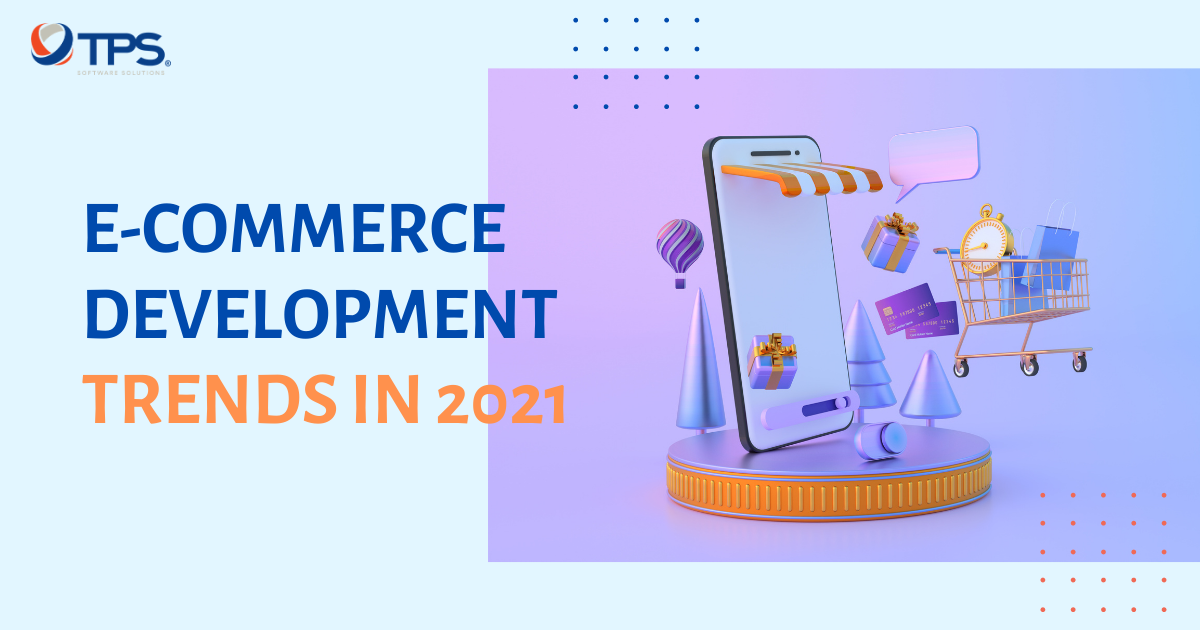2020 was a massive year for eCommerce given the effects of COVID. The pandemic sped up changes across several verticals, and that acceleration is expected to continue in some capacity as we move into 2021 and beyond.
Dozens of online marketplaces emerge daily and stimulate the market’s growth. According to Statista research, the retail market sales will reach the amount of $6.54 trillion in 2023 compared to $3.53 trillion in 2019.
In this article, we will discuss the top 7 e-commerce development trends that dominant in the year 2021
- Customers will shop in marketplaces rather than eCommerce stores
- AR enhances the reality of online shopping.
- AI helps shops learn about shoppers
- There will be a growing volume of voice search.
- Big data plays a big part in creating personalized experiences.
- Chatbots improve the shopping experience.
- Mobile shopping is still on the move.
1. Customers will shop in marketplaces rather than eCommerce stores
The top online marketplaces in the world sold $2.03 trillion in 2019. Sales on marketplace sites, like those operated by Alibaba, Amazon, eBay, and others, accounted for 57% of global web sales in 2019, according to Digital Commerce 360’s analysis. The growth of marketplace e-commerce sales is a reason many large retailers are launching their marketplaces.
As shoppers realize the ease of shopping in a marketplace is easier and more convenient than shopping on multiple eCommerce stores – with the mental satisfaction of 2-3 day shipping and free returns on most items and most marketplaces, consumers will expect the same from all other eCommerce sites. Big eCommerce companies offer the best of both worlds: they provide value to consumers, a low barrier to entry for brands to sell online, and user-generated content that perpetuates both product and content relevance as well as a search rank.
Virtual marketplaces are one of the fastest ways to scale globally. They also help smaller businesses fulfill orders more efficiently. Eventually, people stop at a marketplace for most of the items they need.
2. AR enhances the reality of online shopping.
Augmented Reality (AR) has become a major game-changer when it comes to online shopping, significantly closing the gap of ambiguity. It helps online shoppers visualize the products that they’re interested in, whether it’s a clothing item or furniture. Shoppers can now see how they would look while wearing a certain item or how nice their home would look with a certain paint color. This helps online shoppers overcome the hurdle of not being able to see the product firsthand, bringing comparison shopping to a whole new level.
Gartner predicted that 100 million consumers will shop using AR by 2020.
Michael Prusich, Director of Business Development at 1Digital Agency, agrees with this prediction: “Polls have shown some really powerful numbers in regards to AR too: 35% of people say that they would be shopping online more if they could virtually try on a product before buying it, and 22% would be less likely to visit a brick-and-mortar store if AR was available via their favorite e-commerce store. AR grants a person the ability to not just see a 3D model of a product but lets a user see how it looks if they were actually wearing it. Some products and industries lend themself better to traditional shopping methods, but AR is going to shake things up sooner than later.”
3. AI helps shops learn about shoppers.
Another aspect of brick-and-mortar shopping that has historically been lost in online shopping is a helpful in-store associate who can offer product recommendations and personalized guidance based on the shopper’s needs or requests.
The prevalence of Artificial Intelligence (AI) and machine learning will increase, as retailers target new ways to enhance personalization and improve customer service, which is why all online businesses should invest in this development.
AI can also:
- Help businesses learn about their customers and supply them with the personalized experiences they are demanding.
- Help companies connect customer data with real-time insights to improve the shopping experience.
- Automate tasks such as customer support through chatbots to help customers 24/7 or generate timely offers.
- Optimized pricing and discounting and demand forecasting.
Leading fashion brand Natori used artificial intelligence to make smarter choices for their digital ad spending. The result was a 76% increase in social media revenue.
Ron Smith, Editor in Chief, The Digital Outdoor, emphasizes how the complexity of AI and the ability to make it more human is also increasingly important:
“People want to know that brands care about them, and AI will be programmed accordingly. We have currently seen the opposite behavior on social media, where AIs learn from humans’ more negative remarks, but consumers will likely crave the impact. If bots can learn how to form sentences to convey an emotion, companies can soon teach them to offer comfort and products based on customers’ moods.”
4. Data analytics flourish
In the world of eCommerce, customer data will continue to gain value. Many brands focus on the basic, but vital metrics provided to them, such as click-through-rate on specific campaigns and conversion metrics that indicate where the bulk of traffic and sales are coming from.
However, as we roll into 2021, many will uncover data capabilities and get even more granular.
According to Contensify, “Segmentation is going to go beyond just one-time sales and loyal customers. It’s going to be a lot about how they interact with your eCommerce business. Knowing who your price-sensitive customers are. Knowing which one of your customers would rather buy full-price and who are more likely to abandon carts, and so on.”
5. There will be a growing volume of voice search.
Voice assistants like Siri and Amazon’s Alexa have become popular and have made a significant impact as mobile application trends in recent years.
Voice search enables customers to shop for desired products through a verbal description of what they are searching for. With the emergence of voice search assistants, browsers are no longer the sole driver of online retail traffic.
Experts suggest that as much as 50% of the web searches would be done through voice. Further, as many as 8 billion devices will have in-built voice assistants by the year 2023. Additionally, voice shopping can be increased by 40 billion by the year 2020.
Voice searches are Intuitive and offer a great way of performing quick searches and buy things on the go. However, the growth of voice searches calls for a change in conventional strategies. Voice assistants are the best choice for multitaskers, as these are hands-free and do not require a mouse and keyboard to operate. Mobile e-commerce and apps have a bright future as voice assistants are a great idea for increasing sales revenue.
6. Chatbots improve shopping experiences.
At the crux of personalization and AI capabilities is the cheery chatbot who can serve the role of the brick-and-mortar greeter and salesperson. Chatbots allow stores to communicate with thousands of customers while giving them the feeling of personal attention and thoughtful recommendations based on their responses.
And in reality, a growing number of shoppers actually prefer to converse with bots and other digital self-service tools. One study found that more than 60% of customers report preferring having websites, apps, or chatbots answer their simpler inquiries. One of the major reasons for this is because of the faster response time.
Experts predict that 80% of businesses will be using chatbots in 2020. In addition to just increasing in frequency, there are a number of ways experts predict bots will evolve in the coming years.
According to Shane Barker, Founder, and CEO of e-commerce, “Chatbots are all the rage today for customer support. However, I think they’ll drastically change the way people shop online. They’ll become one of the most important marketing tools. In the retail space, self-checkout kiosks will probably become the norm and in-store marketing will increase.”
Duran Inci, CEO of Optimum7, sees chatbots becoming increasingly personalized to improve the customer experience:
“The same way chatbots are becoming more intuitive, so do I think that personal shopping assistant bots online will become more prevalent, using previous data to help anticipate new products that you’ll like. Similar to Amazon’s suggestions for similar products.”
7. Mobile shopping is still on the move.
So far, we’ve mostly focused on the ways e-commerce is closing the gap and bringing physical store experiences online. However, there are still many things that e-commerce has up to in-person retail. One of the clear advantages is the ability to shop from anywhere.
In 2019, Statista estimated that by the end of 2021, 73% of e-commerce sales will take place on a mobile device. With that in mind, your site must be built using robust responsive design. Consumers should be able to shop on their phones just as easily as they can on their desktops.
Ecommerce businesses are doing their best to provide a smooth user experience on their e-commerce sites with several payment options including e-wallets. China is a leader in online payment, with WeChat and Alipay each having over 1 billion users.
Corey Dubeau, VP of Marketing at Northern Commerce, is one of many who see “improved quality and more mobile payment integrations” to be a harbinger of change in 2020.
Another response to ever-increasing mobile users is the use of PWAs or progressive web apps. PWAs can give mobile shoppers a native app-like experience with features like the ability to work offline and allow push notifications. They can give e-commerce brands another way to improve the customer journey for online shoppers using mobile devices.
Some top e-commerce solutions include:
Drupal Commerce Module with Magento: this is a set of modules that offers Magento functionality into Drupal. On the one hand, Magento is an excellent open-source e-commerce platform well suited to work with the Drupal CMS, which provides unique features to build and manage a website. So, this combination provides you with a powerful e-commerce platform whose front-end can be easily themed and managed
EC-CUBE: an open-source package used to build e-commerce sites. It is the most popular shopping cart system in Japan. Since the release of the version in 2006, users can build e-commerce sites for free. Due to its drag and drop functionality, users with no programming experience can create original online shops with ease. EC-CUBE has also been opened in Vietnam market for online shopping store.
WordPress with WooCommerce: WooCommerce is one of the most popular e-commerce solutions out there. It is based on the WordPress platform and provides a straightforward, powerful, and feature-rich digital shopping experience
SAP Commerce Cloud: this platform offers a simple checkout flow and the opportunity to have all of your selling channels in the same place. For instance, by integrating physical and digital shopping experiences, SAP allows you to see stock availability across all channels in real-time
Salesforce Commerce Cloud: last but not least, Salesforce can help you create unified and intelligent e-commerce experiences, both online and in-store. It is a highly scalable, cloud-based SaaS e-commerce solution that offers best-in-class features to provide a truly optimized e-commerce experience.
——————————————————————————————————–
Having experience in developing e-commerce applications for many customers in various markets such as Japan, North, and South America, TPS Software is one of the most prominent e-commerce outsourcing companies in Vietnam.
Also, TPS Software owns a marketplace platform that could be quickly adopted and accelerate for deployment.
If you have an E-commerce application development project in place or any question on an E-commerce development, don’t hesitate to contact us for a free consultation.














